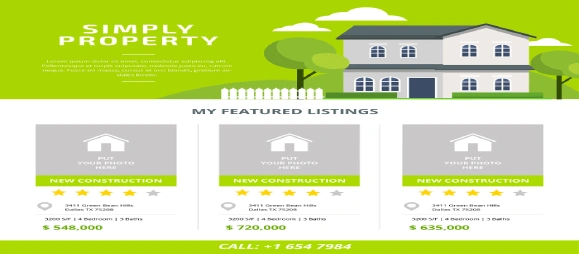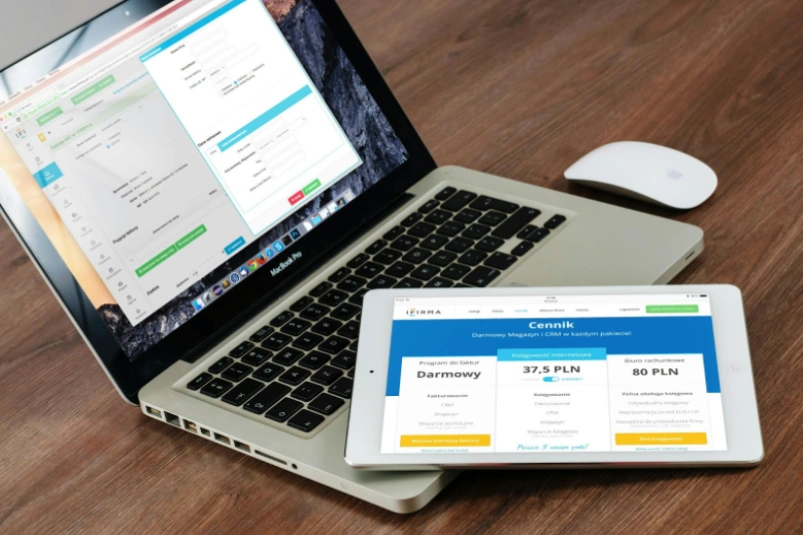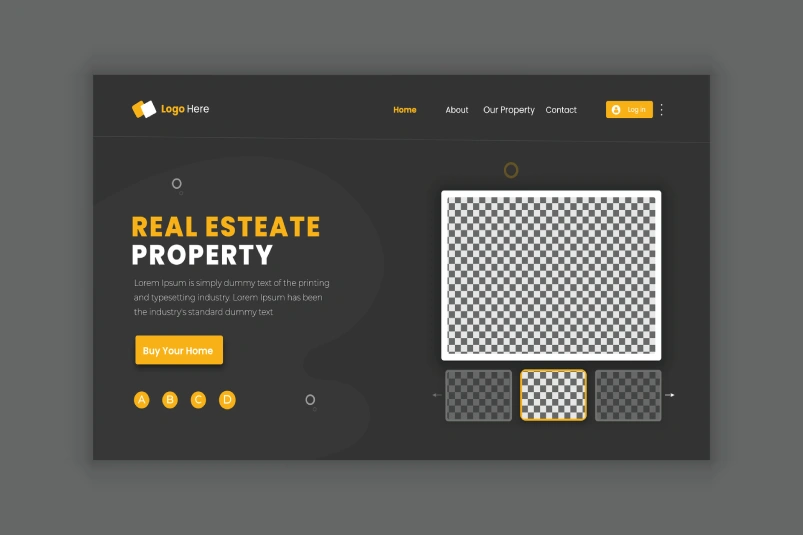
Top Real Estate Website Design Tips for 2024

In an era where digital presence is crucial, a well-designed real estate website is vital for success in the competitive property market. With more buyers and sellers turning to the internet to search for properties, a well-designed real estate website can give you an edge over the competition and help you close deals more efficiently. Your website acts as your digital storefront, and its effectiveness in attracting, engaging, and converting visitors can significantly influence your business outcomes. This comprehensive guide will explore crucial strategies and design tips to help you create an exceptional real estate website.
We’ll cover SEO strategies, property listing management, user experience enhancements, and more, ensuring that your site not only stands out but performs excellently in search engine rankings.
SEO Strategies for Real Estate Websites
SEO (Search Engine Optimization) is essential for improving your real estate website’s visibility and improving its position in search results. Effective SEO strategies will help you reach more people searching for real estate services, bringing them directly to your site.
Key SEO Tips:
- Keyword Research: Identify and use targeted real estate-related keywords. Tools like Google Keyword Planner can help you find high-traffic, low-competition keywords like homes for sale in your city. Choose terms that match what your audience is searching for.
- On-Page SEO: Optimize each page by strategically placing keywords in your titles, meta descriptions, and headings. Ensure each page has a unique description, adding relevant keywords to improve search rankings.
- Local SEO: Focus on location-specific keywords to target local clients. Optimize your Google My Business profile and include local terms in your content to rank higher in local searches.
- High-Quality Content: Regularly publish valuable content such as real estate market trends, home-buying guides, and local area insights. Consistently updated, high-quality content keeps users engaged and helps improve SEO.
Pro Tip: Keep an eye on your ranking techniques and stay informed about any changes in Google algorithms to keep your ranking high.
Optimize Property Listings
Property listings are crucial for any real estate website. The way these listings are designed and organized greatly affects how users interact with the site and how many leads are generated.
Important Points for Property Listings:
- High-Quality Images: Use clear, high-resolution pictures to show each property. Improve the experience by offering virtual tours or 360° views to keep users interested.
- Detailed Descriptions: Give complete information about a property, including its size, features, and location. Emphasize special features to attract potential buyers.
- Search Filters: Use advanced filters that let users narrow down their search by price, location, and property type, making the browsing experience smooth.
- Mobile Optimization: Make sure your property listings work well on mobile devices, since many users search for real estate using smartphones.
Pro Tip: Add clear call-to-action buttons such as “Schedule Viewing” or “Contact Us” to make it easy for potential clients to take the next step.
Real Estate Marketing Tools
Marketing tools can make your real estate website work better and help you reach more people. Use these tools in your marketing plan to make it more successful.
Important Marketing Tools:
- CRM Systems: Use a Customer Relationship Management (CRM) tool to keep track of leads and set reminders for follow-up actions.
- Email Marketing: Send online newsletters and email updates to tell potential clients about new properties, market news, and special offers.
- Social Media Integration: Connect your website to your social media accounts to share property listings and updates. Adding social media sharing buttons for your listings can be helpful.
- Analytics Tools: Use tools like Google Analytics to see how visitors use your site.
Pro Tip: Use marketing automation to manage your campaigns and communicate with the leads more efficiently.

Real Estate Website Optimization
Making your real estate website quicker, more effective, and simpler to use is key for happy users and better search results.
Improvement Ideas:
- Quick Loading: Make pages load faster by making images smaller and reducing the number of times the site asks for information. A slow website can upset a potential buyer.
- Mobile-Friendly: Make sure your website works well on all devices and screen sizes.
- Easy Navigation: Create a simple layout so users can find what they need quickly. Include a menu and a search box.
- Frequent Updates: Keep your website fresh by updating it often to keep users coming back.
Pro Tip: Use tools like Google PageSpeed Insights to check how well your website works, and make any needed changes.
Templates for Real Estate Websites
A Right website template is important for making a professional and easy-to-use real estate website. Use templates that are made especially for real estate business websites.
Important Things to Consider:
- Customization: Pick templates that easily change design parts to match your brand and fit your business needs.
- Necessary Features: Look for templates with features made for real estate, like a search bar for properties, list and grid views, and built-in contact forms.
- Mobile-Friendly: Make sure the template works well on mobile devices, giving users a good experience on phones and tablets.
- Help & Updates: Choose templates from trusted providers that give regular updates and good customer support to keep your website running well.
Pro Tip: If budget allows, invest in a premium template. Premium options often include advanced features, better support, and higher-quality designs.
Organize Page Categories
A well-organized real estate website helps visitors easily find what they need, making their visit better and increasing the chances they’ll take action. Properly arranging your pages is important for guiding users through your site without any problems.
Essential Page Categories:
- Home Page: Your homepage is the first thing visitors see. Show off your main services, feature some great properties, and display recent listings to catch their eye right away. Keep the design simple and interesting, with clear options like “View Listings” or “Contact Us.”
- About Us: Create an About Us page to build trust. Tell your story, share your goals and values, and explain what makes your team special. Adding pictures of your team and a short history can help potential clients feel more connected to your brand.
- Property Listings: Simplify property browsing by organizing listings by type, location, and price. Add easy-to-use search filters so visitors can quickly find homes that fit their needs.
- Blog/News: Keep your audience informed and interested by regularly posting articles in a blog or news section. Share insights on the industry, market trends, buying tips, and neighborhood guides to show your expertise and attract more visitors to your site.
- Contact Us: A well-designed Contact Us page is crucial for getting leads. Include clear, easy-to-find contact information, a simple form for inquiries, and links to your social media profiles. Make sure this page is easy to find by placing it in the main menu.
Pro Tip: Use simple and clear labels for each page, like “Find Your Home” or “Meet Our Team,” to make it easy for users to navigate your site and find what they need.
Virtual Property Tours
Including virtual tour options can significantly improve user experience by allowing potential buyers to explore properties online from their own homes. This is particularly useful for buyers who live far away or want to get a feel for a property before visiting in person.
Important Features for Property Tours:
- Virtual Tours: Offer detailed virtual tours or video walkthroughs that let users explore properties thoroughly and get a good sense of the space.
- Interactive Maps: Use interactive maps to show the property’s location and nearby facilities like schools, parks, and shopping centers.
- High-Quality Videos: Use professional videos to showcase the main features of the properties, emphasizing what makes each one special.
- Easy Access: Make sure property tours are easy to find and access directly from the property listing pages, providing a simple and user-friendly experience.
Pro Tip: Keep property tours up to date with the current state of the properties, and ensure they are optimized for mobile devices to cater to all users.
User Experience Design
Importance of User Experience
In designing real estate websites, user experience (UX) is very important. If a website is well-designed and easy to use, visitors will spend more time on it. Some key aspects of UX include easy navigation, quick page loading, and a design that works well on different devices.
How to Enhance UX
- Clear Navigation: Ensure the website menu is easy to understand and well-organized. Common sections like ‘Buy,’ ‘Sell,’ ‘Rent,’ and ‘Contact’ should be easy to find.
- Quick Loading: Use compressed images and reliable web hosting to make your site load quickly. Fast websites improve user experience and reduce the chance of people leaving quickly, called a bounce rate. Slow websites often have high bounce rates.
- Mobile-Friendly Design: Since many people visit websites on their phones, your site should look good and work well on all devices, especially mobile ones.
Pro Tip: Use analytical tools to track how users interact with your website and use the information you get to improve the user experience.

Real Estate Homepage
Your homepage is often the first page people see when they visit your site. It should make a good impression and clearly show what you do.
Essential Tips for Homepage Optimization
- Clear Call-to-Action (CTA): Add easy-to-see buttons like “Find Homes,” “Call Us,” and “Get a Free Estimate” to help people take the next step.
- High-Quality Images: Use high-quality photos of houses and local places to attract people and show what you offer.
- Search Box: Put a search box on the main page so people can quickly find homes that fit their needs.
Pro Tip: Test different button styles and homepage designs to see which works best for your visitors.
Content Ideas For Real Estate
Good content is important for keeping visitors interested and helping your website rank better in search results. Here are the main things to include on your real estate website:
- Property Listings: Show complete property listings with clear photos, virtual tours, and full descriptions. This attracts buyers and helps them learn about the properties.
- About Us Page: Tell your story, introduce your team, and show your experience. This builds trust and makes visitors feel confident in your abilities.
- Blog Section: Post regularly about market trends, home-buying advice, and interesting local information. A well-kept blog can bring more visitors to your site and show your expertise.
Pro Tip: Keep your blog updated with new content often to keep visitors coming back and improve your search ranking.
Search Features for Real Estate Sites
Improving Search Capabilities
Adding advanced search options can significantly enhance the experience for users on your real estate site, helping them find homes that meet their exact needs.
Key Features to Include
- Filter Options: Give users the ability to refine their search results by choosing criteria such as location, price range, property type, and number of bedrooms.
- Map Search: Add a map search feature to help users see where properties are located and explore various neighborhoods.
- Saved Searches and Notifications: Let users save their search preferences and receive alerts when new properties that meet their criteria are added.
Pro Tip: Use autocomplete and predictive search tools to make the search process smoother and quicker for users.
Strong Visual Presentation
A good-looking website is important for getting people to visit and stay on your site. High-quality images and a well-designed layout can make people enjoy their time on your site and show off your properties better.
Tips for a Strong Visual Display
- Professional Photography: Show your properties in the best way with clear, high-quality pictures and virtual tours.
- Consistent Branding: Use the same colors, fonts, and design styles to make your brand look strong and put together.
- Interactive Features: Include image sliders and video backgrounds to make your site more interesting and interactive.
Pro Tip: Ensure your website’s pictures and other visuals load fast so people can easily look around.
Design a Memorable Real Estate Logo
Your logo is a picture that shows what your business is about. For people who work in real estate, having a unique and reliable logo is very important. A good logo not only shows that you are professional but also helps clients remember and trust you.
- Logo Ideas: Go for a clear, easy-to-understand design. A simple logo is easier to notice and can be made bigger or smaller without losing quality.
- Use Real Estate Signs: Think about adding things like houses, keys, or buildings to show that you work in real estate.
- Pick the Right Colors: Colors can change how people feel. Use colors like blue or green to make people feel professional and trustworthy.
- Choose the Right Words: Pick a font that is easy to read and matches your business style. Avoid fancy fonts that might be hard to read.
Pro Tip: Invest in professional logo design services to create a high-quality, unique logo that sets you apart from the competition.
Optimize Your Background Image
Why Background Images Matter
The background picture on your website is crucial because it creates the right feeling and leaves a lasting first impression. It should fit with your brand and make visitors enjoy their time on your site.
Selecting the Perfect Background Image
- High-Quality and Relevant: Use clear, high-resolution photos related to real estate, like city views, houses, or room interiors. Stay away from common stock photos.
- Think About Your Audience: Select images that your target audience will enjoy. If you sell luxury homes, choose stylish, high-end pictures.
- Keep Text Clear: Ensure the text on your site is easy to read against the background image. You may need to use overlays or adjust the image brightness.
- Responsive Design: Make sure your background image looks nice on all devices, including computers, tablets, and phones.
Pro Tip: Try A/B testing to find out which background images get people to interact and make purchases.
Build Effective Backlinks for SEO
The Role of Backlinks
Backlinks are links from other websites that direct users to your site. They are essential for SEO, as they help boost your website’s authority and improve its ranking.
Strategies for Building Backlinks
- Create Valuable Content: Produce top-notch content that real estate professionals will want to share, like helpful blog articles, thorough market analyses, or engaging case studies.
- Leverage Your Network: Develop connections with other real estate experts and industry leaders. They might link to your work or work with you on guest articles.
- Get Listed in Local Directories: Add your website to local business listings and real estate-specific directories to gain valuable backlinks.
- Engage in Online Communities: Join real estate forums and social media groups. Share your knowledge and include links to your website when it’s appropriate.
Pro Tip: Try to get backlinks from well-known websites in the real estate industry for the biggest boost in SEO.
Professional Website Layout
A well-organized website layout improves user experience and helps visitors find the information they need more easily. For real estate websites, a professional design can help you display properties effectively and attract potential buyers.
Main Features of a Professional Layout
- Easy Navigation: Ensure your website’s navigation is simple and easy to understand. Use clear menus and search tools.
- Property Displays: Show your properties with high-quality pictures, detailed descriptions, and easy-to-use search options.
- Contact Details: Make it simple for visitors to reach you. Provide clear contact information and an easy-to-fill contact form.
- Adaptive Design: Your website should work well on all screen sizes and devices, giving users the best viewing experience.
- Call-to-Action Buttons: Use clear and compelling call-to-action buttons to guide visitors towards actions such as scheduling a showing or signing up for your newsletter.
Pro Tip: Keep changing your website design based on what users say and the data you collect to always make the experience better.
Seek Expert Advice For Website Design
The Importance of Professional Guidance
Even though there are many tools for creating websites on your own, getting advice from experts can help make sure your website follows industry rules and helps your business succeed.
Choosing the Best Designer
- Look for Experience: Pick a web designer who has worked with real estate professionals and knows the special needs of that field.
- Review Past Work: Look at the designer’s past projects to make sure their style matches what you want.
- Check Client Feedback: Read what other clients have said about the designer to see if they are dependable and good at their job.
- Talk About Your Needs and Money: Tell the designer what you want and how much you can spend so they can make a website that fits your needs.
Pro Tip: Work closely with your web designer to build a website that matches your brand and business goals.
Responsive Design for Property Websites
Why Responsive Design is Important:
In our world where most people use mobile devices, having a responsive design is not just a choice—it’s essential. Responsive design makes sure your website looks good and works well on all kinds of devices, like computers, tablets, and phones. Since many people visit websites on their phones, a responsive website helps you reach more potential customers.
Key Elements of Responsive Design:
- Flexible Grids: Use flexible grids that rely on relative units like percentages rather than fixed units like pixels. This allows your website to adapt seamlessly to various screen sizes, ensuring it looks great on both large screens and small devices.
- Scalable Images: On responsive websites, images should change size to fit the device’s screen. Use CSS methods like max-width 100% to keep images from going outside their space, which can mess up the website’s layout.
- Media Queries: Implement media queries to apply different styles based on the device’s characteristics, such as width, height, or orientation. This allows you to tailor the design for optimal appearance and usability on any device.
Boost Lead Generation
Lead generation is crucial for the success of any real estate website. Your site should be strategically designed to attract and convert visitors into leads. Implementing effective lead-generation strategies is essential for turning casual visitors into potential clients.
Key Lead Generation Features
- Contact Forms: Place contact forms prominently on high-traffic pages, such as property listings or the homepage. Keep forms simple by requesting only essential information to encourage more submissions.
- Call-to-Action Buttons: Utilize strong, clear call-to-action (CTA) buttons that guide users towards key actions, such as scheduling a property visit or requesting more details. Ensure CTAs are visually distinct and strategically placed throughout your site.
- Live Chat: Integrate a live chat feature to offer instant support. This allows visitors to ask questions and receive immediate responses, enhancing user interaction and increasing the likelihood of converting visitors into clients.
Pro Tip: Use well-placed call-to-actions to help visitors become potential customers.
Branding Tips for Real Estate Websites
Your website shows what your brand is all about. Good branding helps build trust and credibility with your visitors. Keeping your branding consistent on your website enables you to stand out from others and strengthens your professional image.
Branding Elements to Consider:
- Logo Placement: Your logo should be prominently displayed, ideally in the header of your website. It should be on every page so people can easily recognize your brand.
- Matching Colors and Fonts: Use colors and fonts that match your brand’s style. This creates a unified look, making your website more memorable and professional.
- High-Quality Images: Pictures of your properties, team, and office can make a big difference. Good visuals show that you are reliable and offer quality services.
Pro Tip: Ensure all branding elements are the same across your website to strengthen your brand’s image.
Modern Design Styles for Real Estate
Modern website design trends focus on enhancing user experience and engagement. Staying updated with current styles can make your site more attractive and functional.
Current Trends in Web Design:
- Simple Design: A simple design uses straight lines, ample white space, and a simple color palette. This style helps focus attention on the content and everything neat and organized.
- Interactive Elements: Add virtual home tours, clickable maps, and tools to compare properties. These features make the website more interesting and give users helpful information.
- Strong and Stylish Text: Modern websites often use bold, stylish fonts to create visual interest and highlight important information. Ensure the use of modern design features that improve how people use and enjoy your website.
Pro Tip: Use modern design features that improve how people use and enjoy your website.
Leverage Your Website for Property Marketing
Your website is a powerful tool for showcasing properties. Effective marketing can attract potential buyers and differentiate your listings from others.
Marketing Strategies:
- Detailed Listings: Ensure your property listings have clear descriptions, high-quality photos, and videos. A well-presented listing gives a complete picture of the property and helps buyers imagine living there.
- Virtual Tours: Provide 360-degree virtual tours so users can explore properties from far away. This is especially helpful for buyers who live far away or prefer to see properties online before visiting in person.
- Search Filters: Add advanced search options to help users find properties that fit their needs. These options can include price range, location, property type, and other important features.
Pro Tip: Highlight properties with unique features through engaging media and detailed descriptions.
Testimonials
Testimonials provide social proof and help build trust with potential clients. Positive feedback from past clients can significantly influence new visitors and encourage them to choose your services.
Best Practices for Displaying Testimonials:
- Prominent Placement: Feature testimonials on key pages, such as the homepage or a dedicated testimonial page. This makes it easy for visitors to see positive reviews and gain confidence in your services.
- Authenticity: Use real names and pictures of clients when you can. Reviews with personal details feel more true and have a bigger impact.
- Varied Content: Include both written reviews and video reviews. Video reviews can be especially interesting and give a more personal feel.
Pro Tip: Showcase testimonials prominently to build trust and encourage new client inquiries.
Conclusion
Creating the best real estate website involves carefully planning and executing each step. Real estate web design is not only about visual appeal, it is about creating a lasting and effective experience to turn visitors into clients. Implementing responsive design guarantees that the site operates efficiently regardless of the device used, which increases user convenience. To attract more organic traffic, ensure that your website content is properly optimized using keywords and quality links.
Ensure that the application has functionalities like quality property listings, the ability to tour properties virtually, and search capabilities to meet the users’ demand. A modern and branded logo with a matching color pallet and fonts will enhance the identity and leave a positive first impression. It should not only present properties but also the professional experience and commitment of the author.
Thus, by making small adjustments to your site according to the analytics and feedback, you become a market leader in real estate, which will bring stable growth and success.
If you’re ready to take your real estate firm to the next level, contact us at support@dreambuildr.com and start building your digital marketing strategy today!
Frequently Asked Questions:(FAQ)
How can SEO strategies improve my real estate website?
SEO strategies can improve your website’s ranking in search engines, which increases traffic to your site. You can enhance your ranking by using page categories and building backlinks.
What are the benefits of using property tour features on real estate websites?
Virtual property tours increase engagement by allowing potential buyers to view homes from anywhere. This feature can boost lead conversions and improve property marketing.
How do I choose the right color scheme for my real estate website?
Pick colors that match your brand identity and create the emotions you want your audience to feel. Use contrasting colors for easy readability, and ensure the color scheme complements your logo and overall design.
What should I include in the essential content elements of my real estate website?
Important content includes property descriptions, high-quality photos, and clear ‘calls to action’. You can also improve the site’s effectiveness by following user experience best practices and offering advanced search features.
How can responsive design impact my real estate website’s performance?
Responsive design ensures your website works well on all devices, improving usability and convenience. This flexibility can boost SEO and lead generation by reaching a wider audience.










